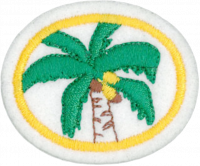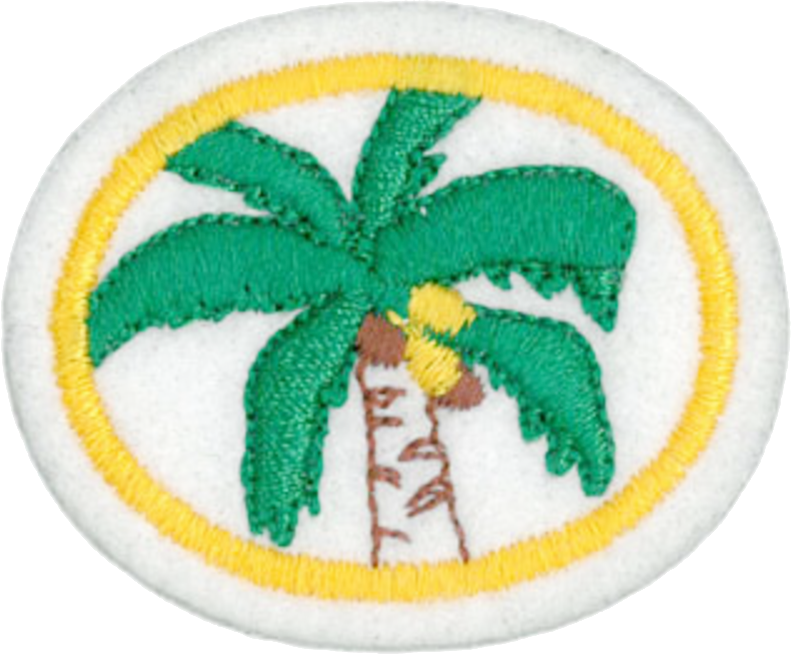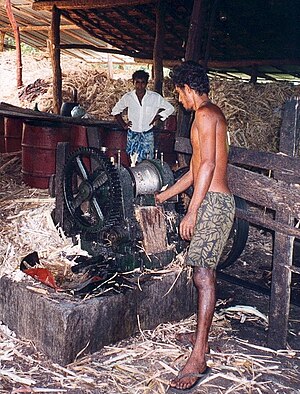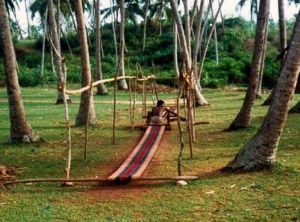Especialidades JA/Palmeras/Respuestas
1
1a
1b
1c
1d
1e
2
3
Sago can be made into steamed puddings such as sago plum pudding, ground into a powder and used as a thickener for other dishes, or used as a dense glutinous flour. In Indonesia and Malaysia, sago is used in making noodles and white bread.
Pearl sago, a commercial product available in many areas, closely resembles pearl tapioca. These two kinds of pearls are similar in appearance and may be used interchangeably in some dishes. This similarity causes some confusion in the names of dishes made with the pearls. Both typically are small (about 2 mm diameter) dry, opaque balls. Both may be white (if very pure) or colored naturally grey, brown or black, or artificially colored pink, yellow, green, etc. When soaked and cooked, both become much larger, translucent, soft and spongy. Both are widely used in South Asian cuisine, in a variety of dishes, and around the world, usually in puddings. In India, pearl sago is called sabudana ("whole grain") and is used in a variety of dishes. Pearls are also used as the "bubbles" in bubble tea (originating in Taiwan).
In addition to its use as a food source, the leaves and spathe of the sago palm are used for construction materials, for thatching roofs, and the fiber can be made into rope.
The starch is also used to treat fiber to make it easier to machine. This process is called sizing and helps to bind the fiber, give it a predictable slip for running on metal, standardize the level of hydration of the fiber, and give the textile more body. Most cloth and clothing has been sized and this leaves a residue which is removed in the first wash.
Coconut Palm
The coconut palm is grown throughout the tropical world, for decoration as well as for its many culinary and non-culinary uses; virtually every part of the coconut palm has some human uses.
Nearly all parts of the coconut palm are useful, and the palms have a comparatively high yield, up to 75 fruits per year; it therefore has significant economic value. The name for the coconut palm in Sanskrit is kalpa vriksha, which translates as "the tree which provides all the necessities of life". In Malay, the coconut is known as pokok seribu guna, "the tree of a thousand uses". In the Philippines, the coconut is commonly given the title "Tree of Life".[10] It its theorized that if you were to become stranded on a desert island populated by palm trees, you could survive purely on the tree and coconut alone, as the coconut provides all of the required natural properties for survival.
Uses of the various parts of the coconut palm include:
Culinary
- The white, fleshy part of the seed is edible and used fresh or dried in cooking.
- Sport fruits are also harvested, primarily in the Philippines, where they are known as macapuno. They are sold in jars as "gelatinous mutant coconut" cut into balls or strands.
- The cavity is filled with coconut water which contains sugar, fiber, proteins, antioxidants, vitamins and minerals. Coconut water provides an isotonic electrolyte balance, and is a highly nutritious food source. It is used as a refreshing drink throughout the humid tropics and is also used in isotonic sports drinks. It can also be used to make the gelatinous dessert nata de coco. Mature fruits have significantly less liquid than young immature coconuts; barring spoilage, coconut water is sterile until opened.
- Coconut milk is made by processing grated coconut with hot water or milk, which extracts the oil and aromatic compounds. It should not be confused with the coconut water discussed above, and has a fat content of approximately 17%. When refrigerated and left to set, coconut cream will rise to the top and separate out the milk. The milk is used to produce virgin coconut oil by controlled heating and removing the oil fraction. Virgin coconut oil is found superior to the oil extracted from copra for cosmetic purposes.
- The leftover fibre from coconut milk production is used as livestock feed.
- The smell of coconuts comes from the 6-pentyloxan-2-one molecule, known as delta-decalactone in the food and fragrance industry.
- Apical buds of adult plants are edible and are known as "palm-cabbage" or heart-of-palm. It is considered a rare delicacy, as the act of harvesting the bud kills the palm. Hearts of palm are eaten in salads, sometimes called "millionaire's salad".
- Ruku Raa is an extract from the young bud, a very rare type of nectar collected and used as morning break drink in the islands of Maldives reputed for its energetic power keeping the "raamen" (nectar collector) healthy and fit even over 80 and 90 years old. And by-products are sweet honey-like syrup and creamy sugar for desserts.
- Newly germinated coconuts contain an edible fluff of marshmallow-like consistency called coconut sprout, produced as the endosperm nourishes the developing embryo.
- In the Philippines, rice is wrapped in coco leaves for cooking and subsequent storage - these packets are called puso.
Non-culinary
- Coconut water can be used as an intravenous fluid.
- Coir (the fiber from the husk of the coconut) is used in ropes, mats, brushes, caulking boats and as stuffing fibre; it is also used extensively in horticulture for making potting compost.
- Coconut oil can be rapidly processed and extracted as a fully organic product from fresh coconut flesh, and used in many ways including as a medicine and in cosmetics, or as a direct replacement for diesel fuel.
- Copra is the dried meat of the seed and, after further processing, is a source of low grade coconut oil.
- The leaves provide materials for baskets and roofing thatch.
- Palmwood comes from the trunk and is increasingly being used as an ecologically-sound substitute for endangered hardwoods. It has several applications, particularly in furniture and specialized construction (notably in Manila's Coconut Palace).
- Hawaiians hollowed the trunk to form drums, containers, or even small canoes.
- The husk and shells can be used for fuel and are a good source of charcoal.
- Dried half coconut shells with husks are used to buff floors. In the Philippines, it is known as "bunot", and in Jamaica it is simply called "coconut brush"
- In the Philippines, dried half shells are used as a music instrument in a folk dance called maglalatik, a traditional dance about the conflicts for coconut meat within the Spanish era
- Shirt buttons can be carved out of dried coconut shell. Coconut buttons are often used for Hawaiian Aloha shirts.
- The stiff leaflet midribs can be used to make cooking skewers, kindling arrows, or are bound into bundles, brooms and brushes.
- The roots are used as a dye, a mouthwash, and a medicine for dysentery. A frayed-out piece of root can also be used as a toothbrush.
- The leaves can be woven to create effective roofing materials, or reed mats.
- Fresh inner coconut husk can be rubbed on the lens of snorkeling goggles to prevent fogging during use.
- Dried coconut leaves can be burned to ash, which can be harvested for lime.
- Dried half coconut shells are used as the bodies of musical instruments, including the Chinese yehu and banhu, and the Vietnamese đàn gáo.
- Coconut is also commonly used as a herbal remedy in Pakistan to treat bites from rats.
- In World War II, coastwatcher scout Biuki Gasa was the first of two from the Solomon Islands to reach the shipwrecked, wounded, and exhausted crew of Motor Torpedo Boat PT-109 commanded by future U.S. president John F. Kennedy. Gasa suggested, for lack of paper, delivering by dugout canoe a message inscribed on a husked coconut shell. This coconut was later kept on the president's desk, and is now in the John F. Kennedy Library.
- Coconut trunks are used for building small bridges, preferred for their straightness, strength and salt resistance
4
The best approach for meeting this requirement is to take a good field guide with you and start looking for palm trees. Once you find a palm tree, use the field guide to identify it. There are field guides specific to palm trees, but these tend to be rather expensive. However, a more general field guide to trees may have information on palms, and these are often less expensive books. You may also find a decent field guide at your local library.
Palms are most commonly seen throughout Africa, South America, the Arabian peninsula, southern and south-east Asia, northern Australia, the islands of tropical and sub-tropical parts of the Pacific Ocean, Mexico, Puerto Rico, Hawaii and some areas of the United States such as California and Florida. Their diversity is highest in wet, lowland tropical forests, especially in ecological "hotspots" such as Madagascar, which has more endemic palms than all of Africa. Colombia may have the highest number of palm species in one country.
Only an estimated 130 palm species grow naturally beyond the tropics, mostly in the subtropics. The northernmost native palm is Chamaerops humilis, which reaches 44°N latitude in southern France. The southernmost palm is the Rhopalostylis sapida, which reaches 44°S on the Chatham Islands where an oceanic climate prevails. Some palms, such as the Trachycarpus fortunei, grow well under cultivation in temperate climates, some as far north as 50°N in oceanic climates (Ireland, Scotland, England, and the Pacific Northwest, from Oregon to Vancouver).
Palms inhabit a variety of ecosystems. More than two-thirds of palm species live in tropical forests, where some species grow tall enough to form part of the canopy and shorter ones form part of the understory. Some species form pure stands in areas with poor drainage or regular flooding, including Raphia hookeri which is common in coastal freshwater swamps in West Africa. Other palms live in tropical mountain habitats above 1000 m, such as those in the genus Ceroxylon native to the Andes. Palms may also live in grasslands and scrublands, usually associated with a water source, and in desert oases such as the date palm.
The number of Palms available in your area may be limited. If palms are not common try a botanical garden or similar where some palms have been imported. You might also expand the definition of "your area" to include wider geography - like if you live in British Columbia your area might need to include the whole West Coast of North America.
5
If you have access to a camera, it is far easier to take several pictures of each specimen while you are out in the field. The pictures can then be drawn from the photos. Be sure to capture the leaves, flowers, seeds, and fruit so that you can reproduce them in your drawings.
You can also draw the pictures in the field.
6
We refer you to Question 4 answers for example information on the Sago and Coconut Palms. Other palms used for food or food preparation include:
Date Palms
Date palms have been cultivated since creation in the Middle East. They remain an important food crop in the Middle East, California etc. The dates are simply harvested and sold, often sun dried, or further processed for use as a natural sweetener.
Copernicia prunifera
Grown only in Northeastern Brazil, this palm is the source of Carnauba wax extracted from the palm's leaves. Carnauba wax produces a glossy finish and as such is used in automobile waxes, shoe polishes, dental floss, food products such as sweets, instrument polishes, and floor and furniture waxes and polishes, especially when mixed with beeswax and with turpentine. Use for paper coatings is the most common application in the United States. It was commonly used in its purest form as a coating on speedboat hulls in the early '60s to enhance speed and aid in handling in salt water environments. It is also the main ingredient in surfboard wax, combined with coconut oil. Because of its hypoallergenic and emollient properties as well as its shine, carnauba wax appears as an ingredient in many cosmetics formulas where it is used to thicken lipstick, eyeliner, mascara, eye shadow, foundation, deodorant, various skin care preparations, sun care preparations, etc. It has many industrial uses as well. Source
Oil Palms
Several species of palms are grown to create the common food ingredient pal oil, extracted from the seeds by crushing them. Malaysia and Indonesia are the primary places of cultivation but oil palms are native to Africa and Central America. The species can be interbread and research on the genome is being done to breed better oil palms.
Açaí Palm
The fruit of this south and central American palm, often called the acai berry, is harvested for food, and often dried and powdered for use as a food ingredient. The fruit is thought to have various health qualities and is commonly sold in capsules, drinks and other forms around the world. Source
Dragon's Blood (various species)
Dragon's Blood is resin from the sap of various palm trees found in China, parts of Africa, and other places. It has long been used in traditional medicines (including as a witchcraft ingredient) but now is finding its way into modern medicine. Research into the resin's possible use as a cancer drug should be watched.
Voyagers to the Canary Islands in the 15th century obtained dragon's blood as dried garnet-red drops from Dracaena draco, a tree native to the Canary Islands and Morocco. The resin is exuded from its wounded trunk or branches. Dragon's blood is also obtained by the same method from Dracaena cinnabari, which is endemic to the island of Socotra.
Dragon's blood resin is produced from the rattan palms of the genus Daemonorops of the Indonesian islands and known there as jerang or djerang. It is gathered by breaking off the layer of red resin encasing the unripe fruit of the rattan. The collected resin is then rolled into solid balls before being sold. Source
Historical Note
This Honor was pioneered as "Palms" in the South Pacific Division before being adapted by the General Conference (with revised requirements) as Palm Trees.




